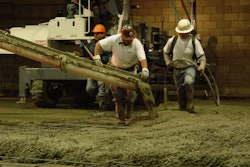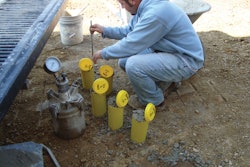The latest revision to ASME B30.27 comes as a follow-up to the 2009 Standard which affected only pumpers and pump manufacturers. In 2014, the rest of the players on a pumped or belted concrete pour are included and given responsibilities to help ensure a safe pour.
“Concrete contractors should obtain a copy of the standard and implement any changes necessary to comply with the specification,” says Robert Edwards, Product Line Manager, Concrete Pumping, with NBIS and Chair of the B30.27 committee. “It’s assumed the specification will be used by regulatory (OSHA) and legal entities (plaintiff attorneys) as a benchmark against which individuals on a jobsite will be judged.”
While all of the standard has meaningful information for contractors, “Chapter 27.3: Operation” contains the information most relevant to concrete contractors. This chapter describes the qualifications and training requirements of the operators, but other workers have had qualifications and responsibilities added also.
The pump owner
According to the standard, the responsibilities of the pump owner include providing a material placement system meeting the machine requirements of the standard, establishing an inspection and maintenance program, training the operation and maintenance personnel, and making sure the equipment meets the requirements of the job.
Communication between the pump owner and the site supervisor/pour supervisor is inherently important. The pump owner is responsible for imparting any requirements for the assembly/disassembly of the equipment, including cleaning, storage and security of any equipment left on the job, and for communicating the need for any auxiliary equipment.
Pump operator
The pump operator is responsible for the safe operation of the material placement system. This individual must be familiar with the requirements of a safe setup and recognize any circumstances that could negatively affect the operation of the unit. The operator must also understand the jobsite hazards and act accordingly near areas of potential danger such as overhead power lines or setup near excavations.
“The number one hazard to the placing crew is hose whipping,” notes Edwards.”The pump operator is required to be trained in the causes and prevention, so the potential of hose whipping is minimized. But the placing crew needs to know of the hazard too and obey the instructions of the operator. That’s why training the placing crew about working with pumps is now a responsibility for their employers.”
Material placement system user
By definition, the material placement system user is the individual who orders the material placement system and controls the equipment when on the jobsite. In many cases, the machine is ordered by the pour supervisor or the site supervisor, so the user’s responsibilities then go to those individuals, in addition to their other responsibilities as defined by the new standard.
Site supervisor
The site supervisor controls the work on site. If the site supervisor ordered the pump, then he also has the responsibilities of the material placement system user.
In some situations, the site supervisor and the pour supervisor may be the same person. The site supervisor is responsible for ensuring operations are coordinated with other activities on the jobsite as well as ensuring the work area is prepared for the work. This individual is also required to address any conditions that might negatively affect the operation such as power line locations, excavations, and traffic routing.
Pour supervisor
The pour supervisor oversees the work being performed by the material placement system and the placing crew. If the pour supervisor ordered the pump, then he/she also has the responsibilities of the material placement system user.
The material supplier/driver
The ready-mixed concrete supplier is responsible for batching, transportation, and delivery of the material to be poured. Note: this person is not responsible for the design of the mix unless asked to provide the design.
The material supplier’s key responsibilities assigned through B30.27-2014 include providing the mix that was ordered, delivering the material on time to prevent blockages caused by old concrete, and training the mixer truck drivers.
The mixer truck driver is responsible for delivering material into the hopper at a rate sufficient to keep the hopper level in the appropriate range, notifying the material placement operator when their truck is empty and/or notification if any foreign material or air is introduced into the pump.
The complete ASME B30.27-2014 Safety Standard can be purchased in booklet form or as a PDF download at this address: www.asme.org/products/codes-standards/b3027-2014-material-placement-systems.
Ed. note: If you have additional questions or would like to schedule training for a group, contact Edwards at
[email protected].



















